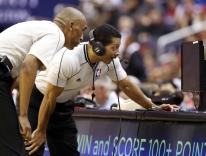In January of this year, over the objections of players, Major League Baseball commissioner Rob Manfred announced that a pitch clock would be introduced in the major leagues for the 2023 season. There would be a thirty-second timer between batters, and during an at bat, pitchers would have fifteen seconds to deliver a pitch after receiving the ball from the catcher when the bases are empty, twenty seconds when there are runners on base. Manfred stated that the pitch clock was a direct response to fan feedback. “What do our fans want to see on the field?” he asked. “Number one, fans want games with better pace.”
I’m on record as opposing the pitch timer, and I opposed it on aesthetic, even theological, grounds:
Baseball has the eternal built into it, from the circular nature of each player’s voyage around the base paths to its refusal to have the game limited by the constraints of time, and the pitch clock introduced something alien to the game, like a virus that couldn’t but compromise the health of something that was otherwise healthy and beautiful.
My own argument against the pitch clock was in large part written in opposition to the constant refrain about the need to speed up baseball’s pace of play in baseball, and I drew on Josef Pieper’s writing on leisure to make my case. In his classic Leisure: The Basis of Culture, the German Catholic philosopher argued that a society dominated by work is inhuman. To be fully themselves, humans need leisure, by which Pieper meant the time and focus required to contemplate things as they really are, to be able truly to see the underlying patterns that give meaning to existence.
Pieper ultimately connects such leisure to the worship of God, but I argued that baseball’s leisurely pace and deep patterns lend themselves to an analogous kind of contemplation, provided that those who attend the church of baseball open themselves in silence and equanimity to baseball’s contemplative dimension. And I suggested that the introduction of a pitch clock would disrupt this dimension by bringing the temporal into the eternal, the mundane into the extraordinary.
I don’t know how else to say this, so I’ll just have to come right out with it.
I was wrong.
In an essay called “Work, Spare Time, and Leisure,” Pieper wrote that it is possible for anyone to “touch, in contemplation, the core of all reality, the domain of the eternal archetypes” when gazing upon a flower or a human face, when listening to a poem, or when focusing on a sculpture or painting. He argues that such contemplation “can happen in countless actual forms,” and while some might quibble with my suggestion that one of these forms could be watching a baseball game, it’s not easy to dismiss the witness of those, like myself, who experience baseball in ways that can only be described as transcendent. Pieper would, I think, understand.
At the same time, Pieper emphasizes that such contemplation can only occur “if the conditions are right.” Some of these conditions have to do with the disposition of the viewer, as I wrote about in my earlier piece when I referred to Pieper’s conviction that the contemplation associated with leisure is possible only for the person who possesses calm and is content simply to be. As I wrote then, such leisure is for Pieper “a condition of the soul,” an “attitude of inward calm, of silence” that “means not being ‘busy,’ but letting things happen.”
What I neglected to consider is that, for this kind of contemplation to occur, one’s internal disposition is not the only factor. It is also necessary that one gaze upon that which is beautiful; it should, in other words, be capable of bringing one to contemplation.
There is, as I’ve argued, something incomparably beautiful about baseball related to what A. Bartlett Giamatti, the former professor of literature and commissioner of baseball, called its “deep patterns.” There are some who think baseball is boring because they’re used to the surges of adrenaline that come with what theologian David Bentley Hart referred to as the oblong games, those sports focused on penetrating an opponent’s territory to deposit or carry an object into a goal or end zone. As a devoted fan of both soccer and hockey, I appreciate the excitement of such sports. But while such games require great skill and provide flashes of beauty, they do not contain within themselves the kind of subtle movements and rhythms baseball does. The threeness of its structure—three outs, three bases, 32 innings and the same number of players on the field—as well as the way baseball dramatizes and celebrates the human impulse to depart from home and to return or at least to help others to do so, all of this speaks to something deep within the us.
The problem is that baseball had morphed into something that obscured these deep patterns, making it difficult to see and experience the beauty of the game. The problem was not the length of the games. NFL games average 3 hours and 12 minutes to play, and college football games take even longer. In 2022, a nine-inning MLB game averaged 3 hours and 6 minutes, but the complaints were generally not about how long it took to play those games, but about what those 3-plus hours of baseball looked like.
Long and meaningless pauses took place between pitches as hitters stepped out of the batter’s box to adjust their gloves or as pitchers meandered around the mound before finally deciding to step on the rubber to throw a pitch. Even then, pitchers could and would take extra time as their catchers went through a battery of signs to determine what kind of pitch the pitcher would throw.
The negative spaces that exist in baseball—the time that exists between pitches or between moments of action on the field—are features, not bugs, of baseball. The silences are, in fact, part of the beauty of the game, part of what gives space for viewers to enter into the leisure necessary for contemplation. But over the past forty years, these negative spaces took over. During the 1970s into the mid-1980s, games regularly averaged around 2 hours and 30 minutes, exemplifying that the pace of play was such that the negative spaces hadn’t overwhelmed the sport. The average time of game started to creep up during the late ’80s into the 2 hour and 50 minute range, where it largely stayed throughout the ’90s. But in 2000, the average time of game reached 3 hours for the first time, and since 2012, the average hasn’t gone below 3 hours, reaching a peak of 3 hours and 11 minutes in 2021. Now, with the introduction of the pitch clock this year, games are averaging 2 hours and 36 minutes, close to the length of games in the 1970s.
There has been some pushback, mostly from veteran pitchers who never had to play with the pitch clock before (it’s been used in the minor league for years). New York Mets ace Max Scherzer complained that pitchers now have to focus on the clock rather than the game, while the Chicago Cubs’ Marcus Stroman said he feels “super rushed.” But these pitchers fail to understand what was being lost in the game without the clock.
I am reminded of a recording I once heard of Thomas Merton teaching the novices at the Abbey of Gethsemani about Vatican II’s Sacrosanctum Concilium, the Council’s document on the liturgy. Merton talked to the novices about how the liturgy is supposed to manifest the “true nature of the church” to those within and without the Church, and he was clear that the liturgy as it was being celebrated prior to Vatican II failed in this respect: “Does it manifest the true nature of the church if you have one guy in a corner mumbling, and an altar boy kidding around with another altar boy and there’s a bunch of nonsense going on, and nobody knows what’s happening, and there’s just a bunch of mumbo-jumbo going on in the corner?”
In the style of Merton, I might ask the following regarding baseball as it developed over the past four decades. Does it manifest the contemplative dimension and beauty of baseball if you have a pitcher wandering aimlessly around the mound between pitches, a batter stepping out repeatedly to adjust the velcro on his batting gloves, players standing in place on the field as they wait for a pitch to be thrown, and spectators staring around at everything except the field where there exists little in the way of rhythm and, because of that, little ability to see the deep patterns and rhythms of the game?
There are many who have argued for the reform of baseball, and some of the recent attempts at reform are profoundly lamentable. The extra-innings zombie runner (or “Manfred Man”) is an abomination, and I regret the universalization of the designated hitter and so the elimination of a key difference between the National and American Leagues.
However, the pitch clock brought baseball back to itself in a way that I could never have predicted. For that, I am grateful.
Please email comments to [email protected] and join the conversation on our Facebook page.
Previous Story
Duke Ellington’s Sacred Swing
Next Story
The Poetry of Reality


